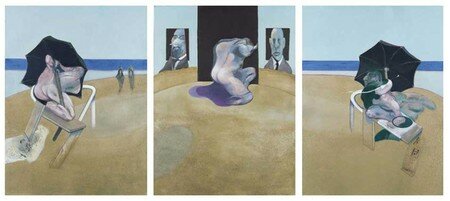Le Tryptique 1974-77 de Francis Bacon sera vendu chez Christie's le 6 février prochain
Francis Bacon, Triptych 1974-77. © Christie's Images Ltd. 2008
LONDON.- Perhaps the most important triptych by Francis Bacon (1909-1992) to ever appear at auction leads Christie’s Post War & Contemporary Art Evening Sale on Wednesday, 6 February 2008. Appearing at auction for the first time and offered from a private collection, Triptych 1974-77 is the last in the great series that Bacon painted in response to the tragic death of his lover George Dyer in 1971.
“Painted just in time for his 1974 show at the Metropolitan Museum of Art in New York as a tribute to George Dyer, Triptych 1974-1977 is the most important triptych by Francis Bacon to appear ever at auction,” said Pilar Ordovas, Head of Post War & Contemporary Art, Christie’s London. “It is a privilege and an honour to be able to work with such a monumental work and present it for sale in London”
Triptych 1974-77 is one of the finest and most mysterious of Bacon’s paintings from the 1970s. Painted between May and June of 1974, this great, strangely open, Baconian landscape was the last work the artist made before a major retrospective of his work held at the Metropolitan Museum of Art in New York in 1974. As the most recent and also one of the most elaborate and ambitious of the artist’s paintings to be included in this exhibition, it formed the culmination of this important survey of Bacon’s career from the late 1960s onwards and was immediately recognised as both a major landmark and also perhaps a turning point in Bacon’s career.
With its sequential images of dark ominous umbrellas and his lover George Dyer writhing and struggling on a near deserted beach overlooked by the spectre of two terrifying monochrome Orwellian witnesses, the subject-matter and the open-air landscape setting of this work, appeared to mark this work as both a conclusion and, a new departure in Bacon’s art.
The exhibition at the Metropolitan Museum of Art was the first major survey of the Bacon’s work to take place since his major retrospective at the Grand Palais in Paris in 1971. It was on the eve of the opening of this exhibition that George Dyer had committed suicide alone in the Paris hotel room that he and Bacon shared. Many of Bacon’s works since then - marking what David Sylvester maintained was the absolute ‘peak period’ of Bacon’s entire career - had been preoccupied with Dyer and the tragic and ugly manner of his death. (courtesy www.Artdaily.com)

/https%3A%2F%2Fprofilepics.canalblog.com%2Fprofilepics%2F1%2F0%2F100183.jpg)
/https%3A%2F%2Fstorage.canalblog.com%2F03%2F02%2F119589%2F96711876_o.jpg)
/https%3A%2F%2Fstorage.canalblog.com%2F11%2F31%2F119589%2F94773502_o.jpg)
/https%3A%2F%2Fstorage.canalblog.com%2F20%2F83%2F119589%2F94772815_o.jpg)
/https%3A%2F%2Fstorage.canalblog.com%2F26%2F72%2F119589%2F75604929_o.jpg)
/https%3A%2F%2Fstorage.canalblog.com%2F59%2F60%2F119589%2F26458628_o.jpg)



/image%2F1371349%2F20240418%2Fob_ac5c4c_telechargement.jpg)
/image%2F1371349%2F20240418%2Fob_709b64_304-1.jpg)
/image%2F1371349%2F20240418%2Fob_22f67e_303-1.jpg)
/image%2F1371349%2F20240417%2Fob_9708e8_telechargement.jpg)